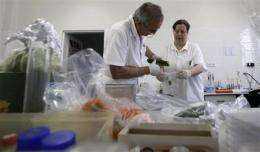E. coli outbreak points to gaps in US food system

(AP) -- The nasty form of E. coli hitting Europe points out gaps in the U.S. food safety system that raise concern that similar outbreaks might happen here.
It's impossible to test for every illness-causing form of E. coli, even the kinds we already know about.
Today, the food industry and health authorities focus mostly on a single strain of the bacteria that until now was considered the most dangerous. But some different strains collectively known as "the other E. colis" were sickening more and more people well before this extra-deadly European bug burst on the scene.
"It's a wake-up call around the world," said Dr. Robert Tauxe of the Centers for Disease Control and Prevention, which has long been concerned about the lesser known strains.
Authorities don't yet know the source of the European infection, but cucumbers, tomatoes and leafy lettuce grown there are suspected.
There's no reason to stop eating fresh vegetables in the United States, but officials are monitoring the situation carefully. The Food and Drug Administration has stepped up testing of those foods imported from affected countries as a precaution, although very little is imported.
And Agriculture Secretary Tom Vilsack said Thursday there's no immediate threat from what's happening in Europe. "We have to constantly look for ways to improve food safety, and that requires us to make sure that we're testing for the right things," he said.
USDA, under pressure from consumer groups, already was working on a measure to address some of the other E. colis in beef, a policy being reviewed by the Obama administration. Researchers created tests to screen for the six strains considered most prevalent, before the toll in Europe revealed a seventh.
When it comes to fresh produce, a sweeping new law requires the FDA to set standards to guard against contamination of all sorts. The rules are expected to address such things as properly processed compost, worker hygiene, and keeping animals and their runoff from fields or irrigation water.
It's not clear how quickly those rules will emerge; Republican-led efforts to cut FDA's budget would strain the work.
"There are no regulations in place today that would prevent this kind of outbreak from occurring" in the U.S., said food-safety expert Caroline Smith DeWaal of the Center for Science in the Public Interest.
But specialists say the broad focus promised by the food-safety law is critical to get ahead of the next emerging germ, rather than racing to develop tests for each new strain.
"You never know what's around the corner that's just waiting to bite you," said former FDA assistant commissioner Dr. David Acheson, now a food-safety consultant. "You cannot test your way to safety, you just can't do it."
The produce industry says it's not waiting on the FDA. Some growers in California and other areas, for example, have voluntarily adopted such standards as not harvesting leafy greens within 5 feet of feces or other animal activity in a field, said David Gombas of United Fresh Produce. What prevents the long-targeted E. coli strain should prevent these newly worrisome varieties, too, he said.
E. coli is incredibly common. Hundreds of strains, most of them harmless, live in the intestines of humans, cows and numerous other animals. But some produce toxins that can cause diarrhea, sometimes severe enough to trigger kidney failure, even death.
The most dangerous form in the U.S. has been the E. coli O157:H7 strain, notorious since a 1993 outbreak at a fast-food chain led to its classification as an adulterant in meat, requiring testing and recalls. A 2006 outbreak in spinach highlighted the threat to fresh produce, too. The CDC estimates that strain alone causes about 63,000 foodborne illnesses a year.
In Europe's unusually large outbreak, an emerging super-strain named O104:H4 has sickened at least 1,600 people and killed 18. Most surprising is that nearly 500 of those victims have that kidney damage, more than typical with other strains.
It's not clear why this particular strain is so virulent. But genetic testing suggests a toxin-spewing form of the bug combined with another strain that attaches to a patient's gut in a more aggressive way - the germs stacking in a brick-like pattern rather than individually, said Acheson. He has long studied E. coli and warned years ago that lesser known strains were "just accidents waiting to happen."
In fact, CDC's Tauxe says that other toxin-forming E. colis altogether cause more illnesses - about 112,000 U.S. cases a year - than the most targeted type. But the other E. colis got less attention because they tended to cause smaller outbreaks, like the one in romaine lettuce blamed for two dozen illnesses in five states last year.
That's why Bill Marler, a Seattle attorney who specializes in food poisoning cases, petitioned USDA to mandate beef testing for the other E. colis, knowing that other foods tend to follow the meat industry.
"If E. coli O157 is an adulterant in hamburger, then these other bugs should be, period," he said.
Tauxe cautions there's a lot to learn about these other E. colis. Later this year, the CDC will begin a study to identify risk factors, what foods and which people seem particularly vulnerable.
©2011 The Associated Press. All rights reserved. This material may not be published, broadcast, rewritten or redistributed.
















